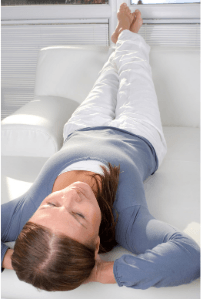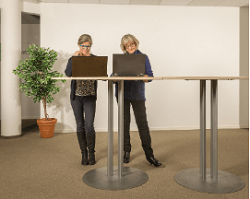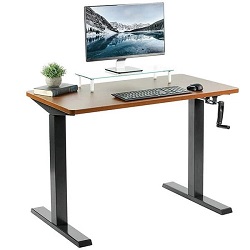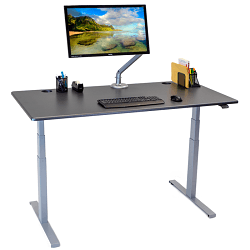 In today’s post we’ll be answering the question…What is a Standing Desk? In the first part we’ll run through some frequently asked questions including how standing desks can help to improve your health and productivity.
In today’s post we’ll be answering the question…What is a Standing Desk? In the first part we’ll run through some frequently asked questions including how standing desks can help to improve your health and productivity.
In the second section we’ll take a look at the different types of standing desks, along with some other options for standing whilst you work.
Buying a new desk – whichever type – is going to set you back a small (or large) chunk of your hard-earned cash, so we’ve also included several links for additional information. This should help you to choose the right solution for your needs.
In This Article…
Part 1 : Q & As
Part 2 : Types of Standing Desk
What is a Standing Desk?
Standing desks allow the user to work whilst standing up. As the names suggest, fixed height desks remain at a particular height whereas adjustable standing desks can be raised or lowered to allow for both sitting and standing work.
There are many different types of standing desks and we’ll be covering them in more detail shortly. But first let’s take a closer look at how standing desks can help to fight the health risks associated with increased sedentary behavior.
What is Sedentary Behavior?

| Sedentary behavior includes sitting, reclining or laying down. It’s any waking activity which uses extremely low levels of energy. |
| A little sedentary behaviour is OK – relaxing after a hard day, watching the TV, listening to music, maybe a little meditation or perhaps reading a book to the kids at bedtime. |
| All good right? Well, here’s the problem – engaging in sedentary behavior for around 7 or more hours per day can start to cause some serious problems, and sedentary behavior is on the rise – both at home and at work. |
Because of this, we are being urged to change our ways in order to reduce the health risks associated with today’s lifestyle.
How to Reduce Sedentary Behavior at Work
| Quite simply, you just need to spend less time sitting. |
| Use a standing desk to alternate between sitting and standing throughout the day. |
| Or a standing desk converter. (These sit on top of your existing desk and raise or lower your equipment.) |
| Under desk treadmills are an excellent way to increase your activity as well – be sure to pair up with the right standing desk if you choose this option. |
| Bicycle desks or under desk ellipticals do the job too. |

We’re not suggesting that you head to the race track with your colleagues – why not try walking meetings instead?
Click here for more on how to reduce sedentary behavior at work.
What are the Benefits of Sitting Less?

The benefits of sitting less include :
- Reduced pains and strains – especially in the back, neck and shoulders
- Lowered risk of heart disease, type-2 diabetes and obesity
- Improved mood, energy, productivity and even sleep patterns.
But this is just the tip of the iceberg. By making changes now you could be adding years onto your life.
To find out more about at the effects of sitting – or standing – too much, check out our post Is A Standing Desk Good For You?
Types of Standing Desk
The Fixed Height Desk
| As the name suggests, the fixed height desk is a pretty basic example of the standing desk which offers no options for height adjustment. |
| You can still alternate between sitting and standing at a fixed height desk, but you’ll need to choose the right chair. |
| Drafting chairs and some adjustable seating will give you the extra height you need. |

The Semi-Adjustable Desk
| This option is slightly more versatile and will allow you to adjust the height of your desk, but it’s more of a one-off solution than a regular up-and-down throughout the day adjustment. |
| Semi-adjustable desks usually come with pre-drilled holes in the legs so you can secure your desk at the required height with screws, locking pins and the like. |
| As with fixed height standing desks, choose the right chair to enable seated work as well. |

The Fully Adjustable Desk
The fully adjustable standing desk allows you to go from sitting to standing and back again throughout the day with minimal fuss. You can choose between manual and electric adjustment.
Manual Adjustment

| Some manual standing desks use a crank system for elevation and lowering. Operation requires an amount of effort and upper body strength. If you’re lacking in this area, the crank option may not be your best choice. |
| Other manual options use counterbalance for elevation through either a spring-loaded or gas strut mechanism. These require little or no effort to operate but tend to cost more than their crank operated counterparts. |
Electric Adjustment

| Basic models feature simple up or down operation. More advanced electric desks have a memory function so you can pre-set your favorite heights – useful for multiple users. |
| Electric desks usually come with single or dual motors but may use 3 or more for L-shaped desks or larger conference-style models. |
| If you opt for an electric desk, look for models which come with a good motor warranty. |
To find out more about standing desks (including our top recommendations) click here.
Other Stand-Up Solutions
The Standing Desk – Frame Only
| Another option is to buy the frame or base only. This can be an ideal solution if you have an existing desk top in good condition which you don’t wish to part with. |
| Make sure you choose a frame which can support your existing top plus all of your equipment. Of course, choosing the correct width and length is important as well. |
| Choose either manual or electric lift. Click here for our top picks. |

The Standing Desk Converter
| If you’re not quite ready to take the plunge and invest in a standing desk, perhaps a standing desk converter will suit you better. This will give you many of the benefits of a standing desk without the need to drastically change your current set-up. |
| Standing desk converters sit on your existing desk and raise or lower your equipment to provide you with a working platform whilst sitting or standing. |
| There are many different types and styles to suit your taste and budget. To find out more, check out our article What Is A Standing Desk Converter? |

The Standing Desk Sum-Up
As well as answering the question “What is a Standing Desk” we hope you found the rest of today’s post useful if you’re considering how and why to sit less at work.
Sedentary behavior can contribute to some serious health issues and more of us are sitting for far too long when we’re at work. But the good news is, most of us can cut down the health risks by making some simple adjustments to the way we work.
There are options and solutions for different budgets and requirements – we’ve just scratched the surface in this article – so be sure to check out our other posts for further and more in-depth information.
Finally, if you have any questions or comments, reach out and drop us a line. You can use the comments box below or email jane@jetofficesolutions.com.
